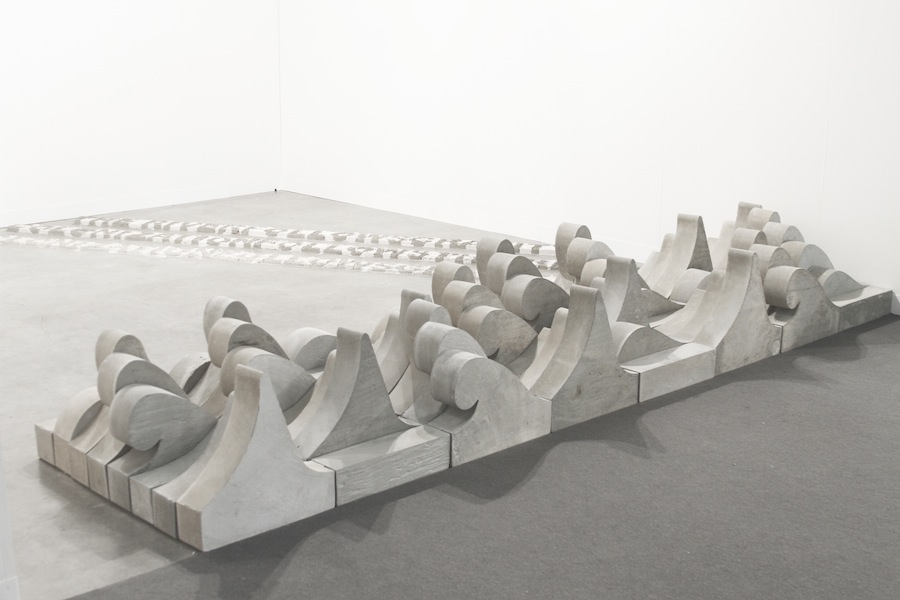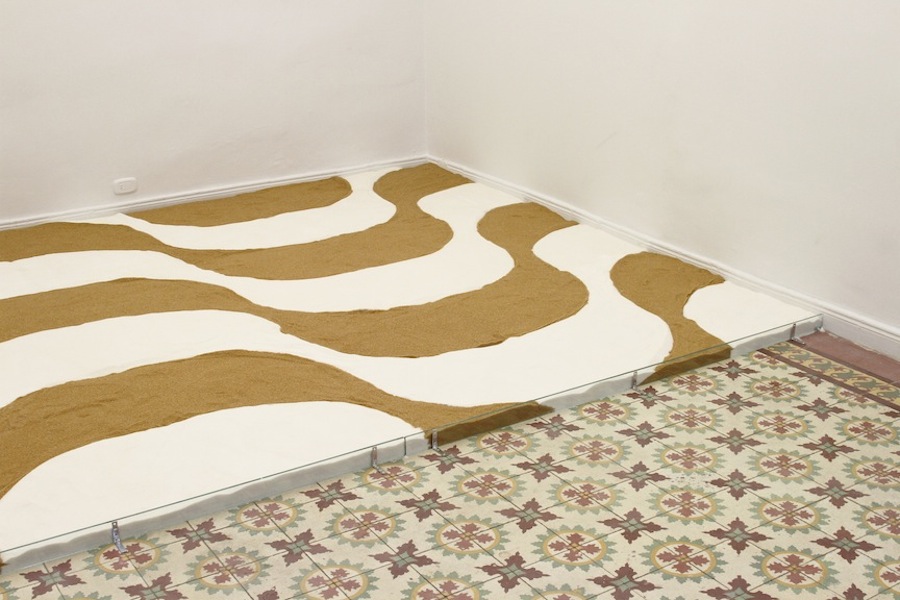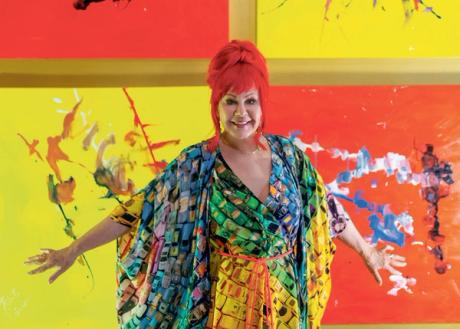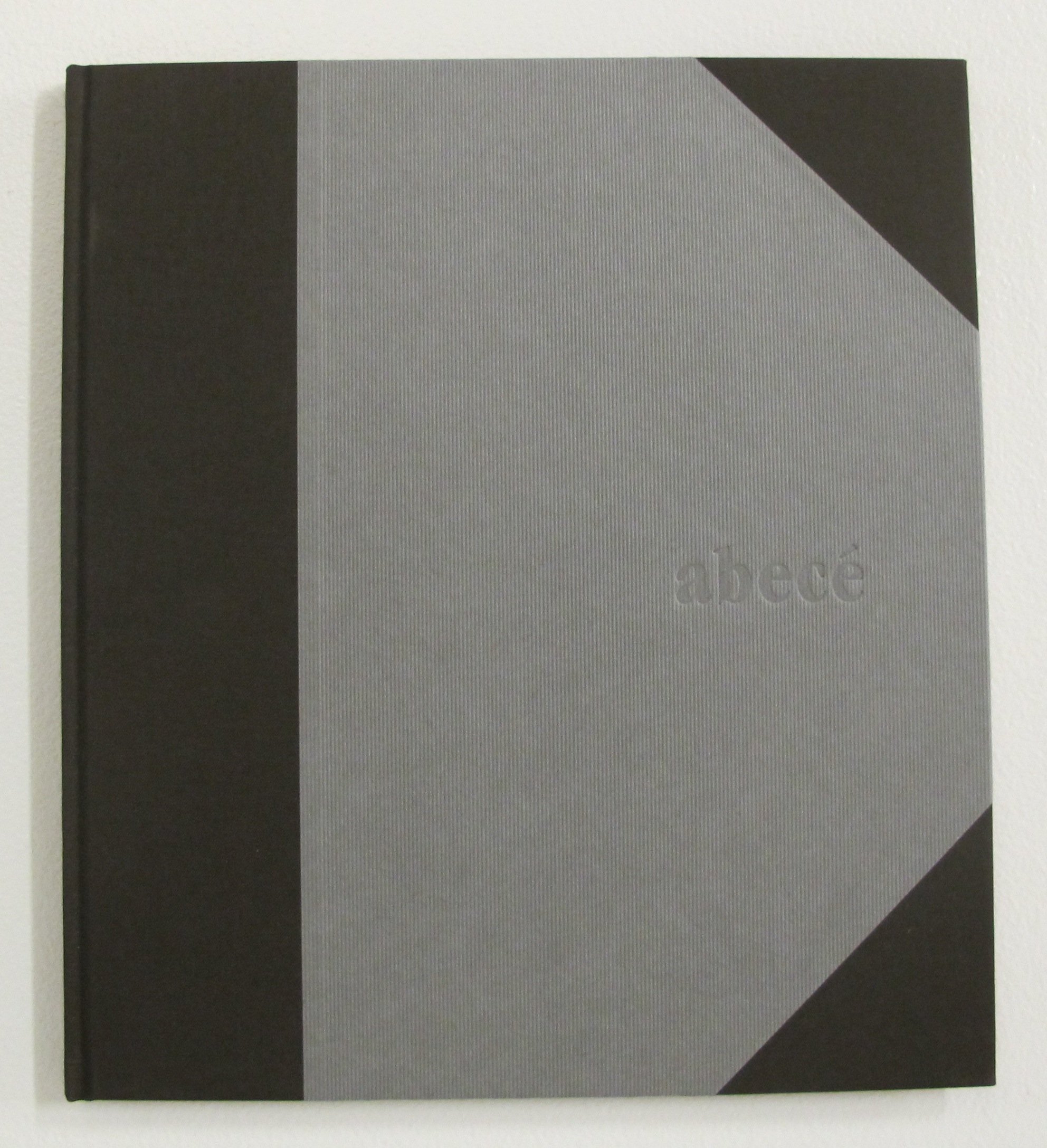Juego de Banderas
2016 - Painting (Painting)
Antonio Caro
Juego de Banderas (a play on words that loosely translates to both set of flags and game of flags) is a triptych of modified Colombian flags by Antonio Caro. Although the yellow, blue and red stripes on the first flag are faithful to the original, the second flag at the center has been modified to feature the word Colombia, emulating the typography and white-on-red design of the iconic Coca-Cola brand. Caro’s first version of this logo was a 1976 graphite drawing, and he has since produced several variations in different materials. Equally relevant now as it was in the 70s, the logo juxtaposes the idea of national identity with the process of intrusion of a foreign commercial emblem and problematizes the growing consumerism brought forth by the economic and cultural americanization experienced in Colombia and all across Latin America. A third flag on the right shows a related but different modification: the yellow stripe that symbolizes gold and the country’s riches and wealth has been rendered in black, and the only yellow remaining is used to spell out the word ‘mineria’ (mining). As per several of his works, Juego de Banderas employs symbolic elements in order to instigate a civic dialogue around issues Caro perceives around him.
One of the founders of the Conceptual Art Movement in Colombia, Antonio Caro’s idea-based works are rooted in the social issues of his country. He began showing work in the late 60s in Bogota and subsequently became an important figure in the global artistic scene, developing in over five decades a distinctive, humorous, and highly idiosyncratic visual language with an emphasis on text and other graphic elements. Some of his best known works appropriate and misuse the typography of iconic international advertising brands—such as Coca-Cola and Marlboro—as means to comment of the social and political conditions of his native Colombia and their relationship to the imperialist and capitalist hierarchies of power that now grip their reality. Although he initially gained notoriety as a conceptual artist, over the years his practice has resisted categorizations, easy commercialization—through his choice of materials such as salt, achiote, cardboard and paper scraps—and has consistently questioned the label of ‘political art’ through his distinctive use of sarcasm, wit, and critical sense of humor.
Colors:
Related works of genres: » conceptual art, » contemporary artist, » conceptualization, » contemporary painters, » painter, » born 1950
» see more

© » KADIST
Keith Tyson
The work of Keith Tyson is concerned with an interest in generative systems, and embraces the complexity and interconnectedness of existence...

© » KADIST
Cildo Meireles
1975Meireles, whose work often involves sound, refers to Sal Sem Carne (Salt Without Meat) as a “sound sculpture.” The printed images and sounds recorded on this vinyl record and it’s lithographed sleeve describe the massacre of the Krahó people of Brazil...

© » KADIST
Mark Bradford
2012This untitled work from 2012 is a print originally made as part of the Wattis Institute for Contemporary Art’s artist limited edition series...
Related works featuring themes of: » Colombian
» see more

© » KADIST
Felipe Arturo
2012Primero estaba el mar ( First Was the Sea , 2012) is a system of equivalences between syllables and silhouettes of waveforms cast in cement...

© » KADIST
Felipe Arturo
2012Defined as entropy, the second law of thermodynamics proposes that energy is more easily dispersed than it is concentrated...

© » KADIST
Bernardo Ortiz
2011Casa de la cabeza (2011) is a drawing of the words of the title, which translate literally into English as “house of the head.” Ortiz uses this humorous phrase to engage the idea of living in your head....

© » KADIST
Mateo Lopez
2012With Roca Carbón (Charcoal Rock, 2012) and Roca Grafito ( Graphite Rock , 2012), López plays with our relationship to inert and unremarkable objects such as rocks...
Other related works, blended automatically
» see more

© » KADIST
Felipe Arturo
2012Primero estaba el mar ( First Was the Sea , 2012) is a system of equivalences between syllables and silhouettes of waveforms cast in cement...

© » KADIST
Felipe Arturo
2012Defined as entropy, the second law of thermodynamics proposes that energy is more easily dispersed than it is concentrated...

© » KADIST
Bernardo Ortiz
2011Casa de la cabeza (2011) is a drawing of the words of the title, which translate literally into English as “house of the head.” Ortiz uses this humorous phrase to engage the idea of living in your head....

© » KADIST
Nicolás Consuegra
2014Consuegra’s Colombia is a mirror made in the shape of the artist’s home country—a silhouette that has an important resonance for the artist...
Related works sharing similar palette
» see more

© » THEARTNEWSPER
Art Basel in Miami Beach Diary: B-52s monkey around, channelling Marina Abramović and the Pérez gets its funk on Art market Museums & heritage Exhibitions Books Podcasts Columns Technology Adventures with Van Gogh Search Search Art Basel in Miami Beach 2023 blog Art Basel in Miami Beach Diary: B-52s monkey around, channelling Marina Abramović and the Pérez gets its funk on Plus: Scope gets in a pickle(ball), Perrotin says do look up and Elberto Muller takes the slow train The Art Newspaper 9 December 2023 Share Kate Pierson, singer with the 1980s band the B-52s, with one of the works on show at the Spectrum Miami art fair that were jointly created by band members and a group of chimps...

© » ARTS EQUATOR
Weekly Picks: Malaysia (3 – 9 Sept 2018) | ArtsEquator Thinking and Talking about Arts and Culture in Southeast Asia Weekly To Do September 3, 2018 Merdeka State of Mind documentary screenings , at APW, 8 & 9 Sept, 8pm A celebration of freedom of expression in Bangsar, this festival features two nights of timely documentary screenings: the subjects of child brides in Malaysia, and the Orang Asli blockades currently under siege in Kelantan...

© » KADIST
Where To Score Edited by Jason Fulford and Jordan Stein Published by J&L Books and KADIST San Francisco Oracle was a countercultural newspaper published in the city’s bustling Haight Ashbury neighborhood from September 1966 to February 1968, bookending the iconic “Summer of Love.” In 12 issues combining poetry, spirituality and speculation with revolutionary rainbow inking effects, the Oracle reached well beyond the Bay Area and spoke to a radical new American ethos...
Related works from the » 2010's created around » Bogotá, Colombia
» see more

© » KADIST
Johanna Calle
2011Johanna Calle’s Abece “K” (2011) is part of a series of drawings (compiled into an artist book called Abece ) based on the alphabet...

© » KADIST
Nicolás Consuegra
2012A residency program in the blazing hot city of Honda, Colombia, inspired artist Nicolás Consuegra to consider the difficulty in understanding the needs of a distant community...

© » KADIST
Bernardo Ortiz
2011Casa de la cabeza (2011) is a drawing of the words of the title, which translate literally into English as “house of the head.” Ortiz uses this humorous phrase to engage the idea of living in your head....

© » KADIST
Nicolás Paris
2012Nicolas Paris studied architecture and worked as an elementary school teacher before he decided to become an artist...
Related artist(s) to: Antonio Caro » Cildo Meireles, » Eugenio Dittborn, » Latin America, » Lotty Rosenfeld, » Mona Hatoum, » Pedro Reyes
» see more

© » KADIST
Cildo Meireles
1975Meireles, whose work often involves sound, refers to Sal Sem Carne (Salt Without Meat) as a “sound sculpture.” The printed images and sounds recorded on this vinyl record and it’s lithographed sleeve describe the massacre of the Krahó people of Brazil...

© » KADIST
Pedro Reyes
2012Pedro Reyes’s Los Mutantes ( Mutants , 2012) is composed of 170 plates that combine characters from ancient and modern mythologies...
Related works found in the same semantic group
» see more

© » KADIST
Kwan Sheung Chi
2007A Flags-Raising-Lowering Ceremony at my home’s cloths drying rack (2007) was realized in the year of the 10th anniversary of the establishment of The Hong Kong Special Administrative Region of the People’s Republic of China...

© » KADIST
Mauricio Ancalmo
2010War Footage is a series of wall-mounted works composed of 16mm film leader, tightly bound to flag-shaped panels by the artist...

© » KADIST
Fred Wilson
2009Fred Wilson’s flag paintings document the 20th century history of African people, indexing the period of liberation from colonialism...





